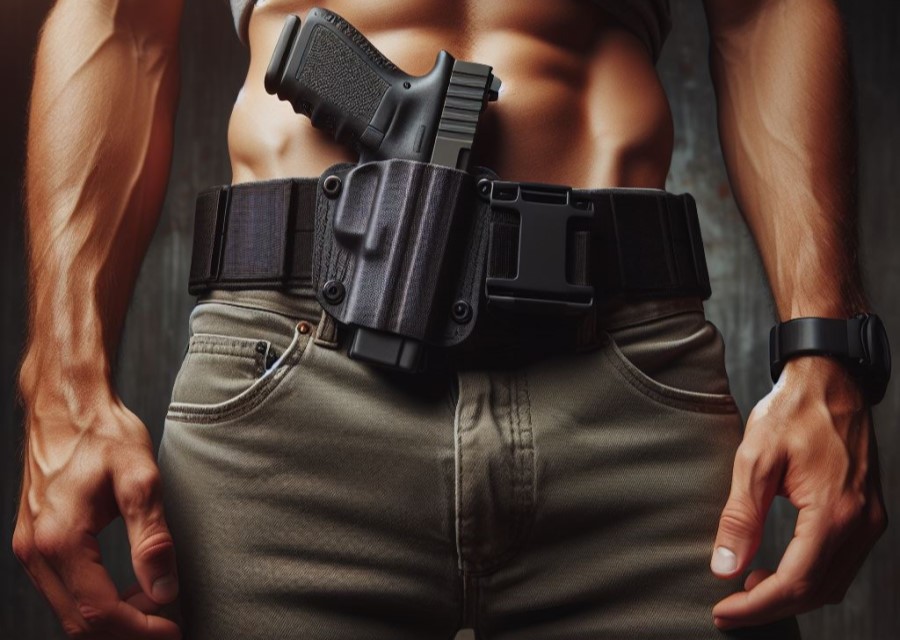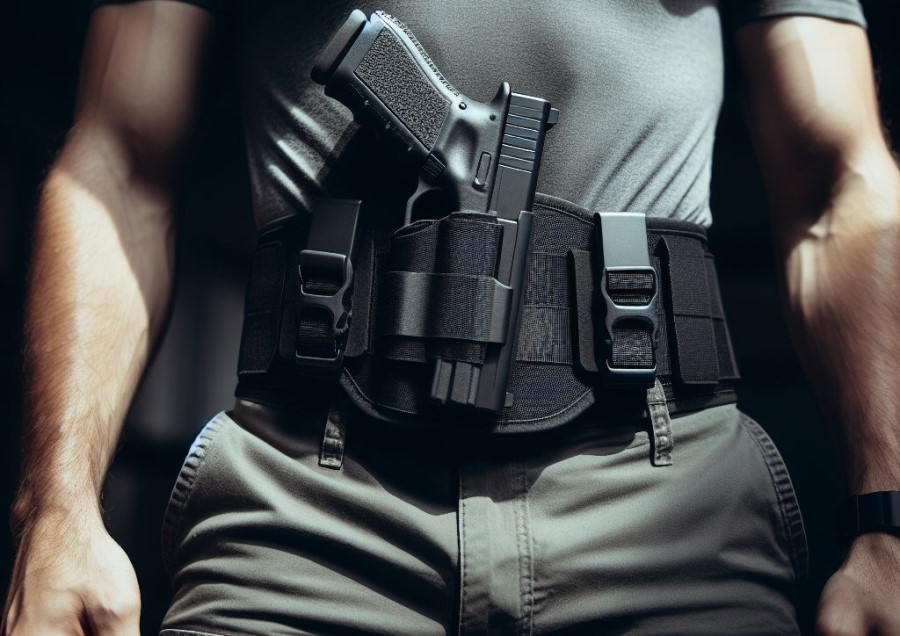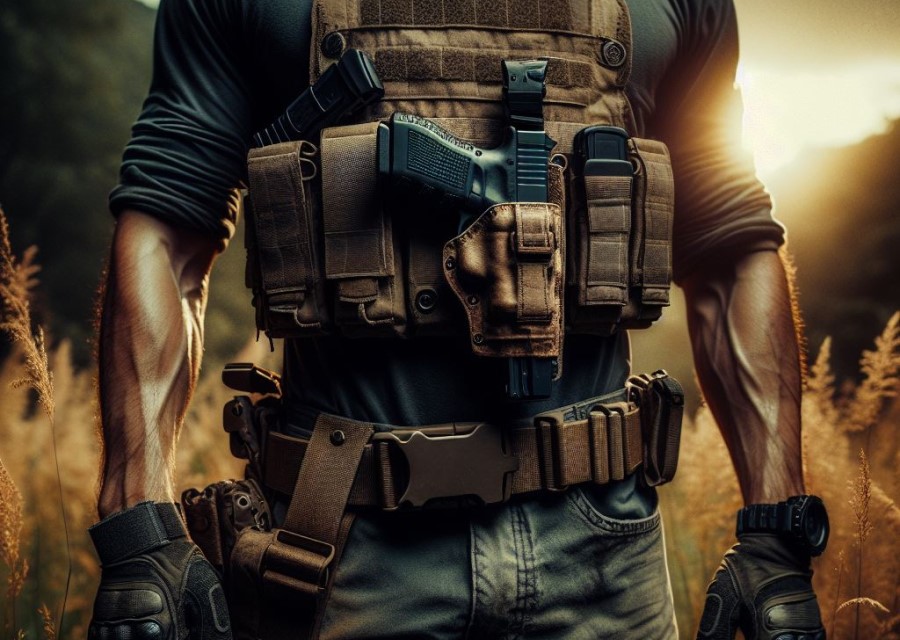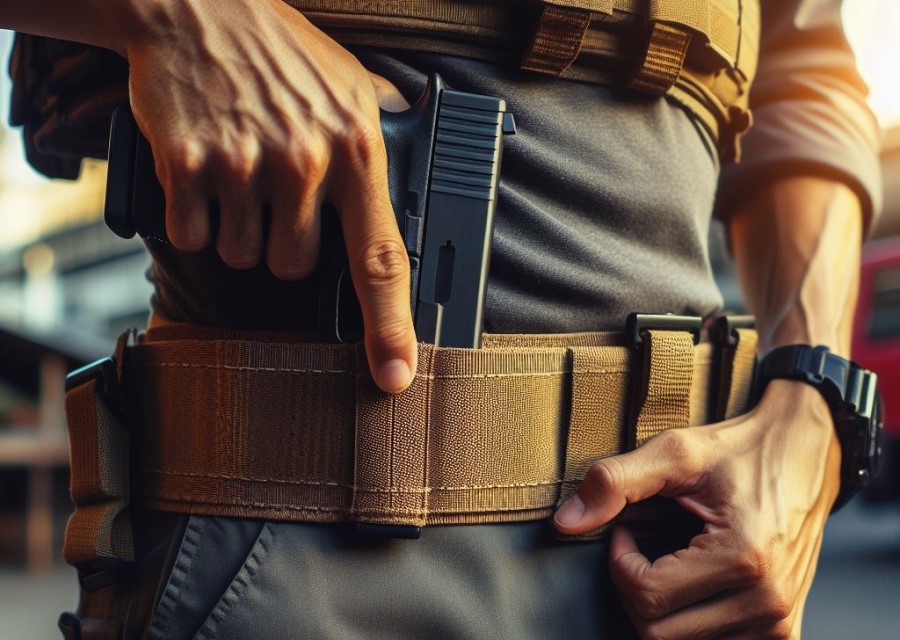A belly band holster is a versatile and comfortable method of discreetly carrying a concealed firearm. It is designed as a wide elastic band that wraps around the waist, providing a secure and easily accessible holstering option. Whether you choose to wear it for personal protection or as part of your job, a belly band holster offers several advantages.
In this article, we will discuss what a belly band holster is, why it is a popular choice, and most importantly, how to wear a belly band holster properly. We will provide step-by-step instructions on selecting the right size and style, positioning the holster, adjusting the tension, and securing it properly.
We will share valuable tips for ensuring comfort and concealment, such as dressing appropriately, experimenting with placement, and using sweat shields or padding. It is essential to practice proper safety measures when using a belly band holster, and we will cover the importance of trigger guard protection, as well as safe drawing and holstering techniques.
By following these guidelines, you can confidently and comfortably wear a belly band holster, ensuring the safety and accessibility of your firearm whenever you need it.
What is a Belly Band Holster?

A belly band holster is a type of concealed carry holster that is worn around the waistband.
It is designed to hold a firearm securely and discreetly against the body.
The holster, known as a belly band holster, is typically made of a stretchy and breathable material, providing comfort and flexibility for the wearer.
It is adjustable to fit different waist sizes and can be worn under clothing for concealed carry.
The belly band holster allows for easy access to the firearm, making it a popular choice for individuals who want to carry a concealed weapon for self-defense purposes.
Additionally, the holster can also accommodate extra magazines or other small items such as a flashlight or a knife.
Why Choose a Belly Band Holster?
Why Choose a Belly Band Holster?
- Affordable: Belly band holsters are often more cost-effective compared to other types of holsters.
- Versatile: They can be worn with various types of clothing, including dresses, skirts, and athletic wear.
- Comfortable: Belly band holsters are designed to provide a comfortable fit, with adjustable bands and padding for added comfort.
- Concealment: They offer excellent concealment, allowing you to carry your firearm discreetly.
- Accessibility: With a belly band holster, your firearm is easily accessible, allowing for quick and efficient drawing of your weapon when necessary.
- Retention: Many belly band holsters have retention straps or features to secure your firearm in place during movement.
- Carry Variety of Firearms: Belly band holsters can accommodate different types and sizes of firearms, offering flexibility for gun owners with multiple firearms.
- Safety: Belly band holsters provide an added layer of safety by keeping your firearm close to your body and preventing accidental discharge.
How to Wear a Belly Band Holster Correctly?

Want to know how to wear a belly band holster correctly? Look no further! We’ve got you covered with a step-by-step guide.
First, we’ll discuss how to select the right size and style of holster. Then, we’ll dive into positioning the holster for optimal comfort and accessibility.
Next up, we’ll show you how to adjust the tension for a secure fit. Finally, we’ll cover the essential step of securing the holster in place.
Get ready to rock your belly band holster like a pro!
Step 1: Select the Right Size and Style
When choosing the right size and style for a belly band holster, it’s important to follow these steps:
- Measure your waist or hips using a tape measure. This will help you determine the correct size of belly band holster to purchase.
- Consider the type of firearm you will be carrying. Different styles of belly band holsters are designed to accommodate different types and sizes of firearms.
- Choose a belly band holster with adjustable straps or fasteners. This will allow you to customize the fit and ensure a secure and comfortable carry.
- Look for a belly band holster that offers additional pockets or compartments. These can be useful for carrying extra magazines, a cell phone, or other small items.
- Consider the material and construction of the belly band holster. Look for high-quality materials that are durable and will securely hold your firearm.
- Read customer reviews and recommendations to get an idea of the fit and comfort of the belly band holster. This can help you narrow down your options and choose the best one for you.
By following these steps, you can ensure that you select the right size and style of belly band holster that will fit you properly and securely hold your firearm.
Step 2: Positioning the Holster
When positioning the belly band holster, it is important to follow these steps:
- Ensure that the holster is centered on your body, aligning the grip of the firearm with your dominant hand.
- Position the holster low on your abdomen, just above your hips, to make sure it stays concealed under your clothing.
- Adjust the angle of the holster for easy access and comfortable drawing of the firearm.
- Tightly secure the holster against your body using the adjustable straps or fasteners provided.
- Make sure the holster is positioned in a way that allows for a quick and smooth draw of your firearm when necessary.
Properly positioning the holster is crucial for both comfort and safety. By following these steps, you can ensure that the holster remains secure, easily accessible, and discreetly concealed under your clothing.
Step 3: Adjusting the Tension
Adjusting the tension of a belly band holster is an essential step in ensuring a secure and comfortable fit. Here is a step-by-step guide on how to adjust the tension:
- Step 1: Start by wearing the belly band holster around your waist, positioning it in the desired location.
- Step 2: Locate the adjustable straps or fasteners on the belly band holster. These are typically located on the sides or back.
- Step 3: Gradually tighten the straps or fasteners to achieve a snug fit. Avoid overtightening, as it may restrict your movement and cause discomfort.
- Step 4: Test the tension by moving around, bending, and sitting. Adjust the straps or fasteners as needed to find the perfect balance of security and comfort.
- Step 5: Once you are satisfied with the tension, ensure that the holster remains in position without shifting or sliding during movement.
Pro-tip: It is recommended to periodically check and readjust the tension of your belly band holster to maintain a secure and comfortable fit, as factors like body size, clothing thickness, and firearm weight can affect the tension over time.
Step 4: Securing the Holster
To securely fasten the belly band holster, follow these steps:
- Place the unloaded firearm into the holster.
- Ensure the trigger guard is fully covered and protected.
- Wrap the belly band around your torso, positioning it in the desired location.
- Tighten the band to achieve a snug fit, ensuring it is comfortable yet secure.
- Double-check that the firearm is properly holstered and does not shift or move excessively.
- If necessary, adjust the tension of the belly band to enhance stability without sacrificing comfort.
- Secure any additional straps, closures, or fasteners provided with the holster.
Tips for Comfort and Concealment

Looking to enhance your comfort and concealment when wearing a belly band holster? Look no further!
In this section, we’ll dive into some valuable tips that will revolutionize your experience. From dressing appropriately to experimenting with placement, and even utilizing sweat shields or padding, we’ve got you covered with practical strategies to make wearing a belly band holster a breeze.
So, let’s get started and take your concealed carry game to the next level!
Tip 1: Dress Appropriately
When it comes to wearing a belly band holster, dressing appropriately is a crucial tip to ensure comfort and concealment.
- Choose clothing that is loose-fitting to prevent the holster from bulging or printing through your clothes.
- Avoid wearing tight or clingy fabrics that may cling to the holster and reveal its presence.
- Opt for shirts or blouses that offer sufficient coverage to prevent the holster from being exposed, especially when bending or reaching.
- Consider wearing an undershirt or tank top underneath your clothing to create an additional layer of coverage.
- Wear pants or skirts with a sturdy belt to provide support and prevent the holster from sliding or shifting during movement.
- Avoid wearing clothing with excessive decorations, such as large buckles or patterns, which may draw attention to the holster.
- Choose neutral colors or patterns that blend in with your surroundings and minimize the visibility of the holster.
- Remember to dress appropriately for the specific occasion or environment in which you will be wearing the holster.
By following these tips and selecting suitable attire, you can enhance the comfort and effectiveness of wearing a belly band holster.
Tip 2: Experiment with Placement
When it comes to wearing a belly band holster, it’s important to experiment with placement to find the most comfortable and effective position for your needs. Here are a few tips to consider:
- Try different positions: Experiment with wearing the belly band holster at different points around your waist to see which placement feels most secure and accessible for quick drawing.
- Experiment with Placement: Each individual’s body shape is unique, so what works for one person may not work for another. Take the time to try different placements that align with your body’s contours for optimal comfort and concealment.
- Adjust tension: Depending on where you choose to position the belly band holster, you may need to adjust the tension to ensure a snug fit. Tighten or loosen the band to find the right balance between comfort and securing the holster in place.
- Practice drawing: Once you have found a suitable placement, practice drawing your firearm from the belly band holster. This will help you become familiar with the movement and ensure a smooth and safe draw in case of an emergency.
By experimenting with different placements and finding the one that suits your body shape and comfort preferences, you can ensure that your belly band holster provides optimal concealment and easy access to your firearm when needed.
Tip 3: Use Sweat Shields or Padding
Taking care of your belly band holster means using sweat shields or padding to maximize comfort and prevent moisture buildup.
- Incorporate sweat shields: These handy, thin pads can be inserted between your body and the holster. They effectively absorb moisture, preventing sweat from reaching your firearm and causing any discomfort. Opt for sweat shields made from moisture-wicking fabric or neoprene for optimal results.
- Padding matters: Some belly band holsters come equipped with built-in padding to offer extra cushioning and avoid chafing. Strategically place this padding on areas where the holster comes into contact with your body to enhance comfort.
- Proper care is crucial: Regularly clean and replace your sweat shields or padding to maintain hygiene and prevent unpleasant odors. Follow the manufacturer’s instructions for cleaning and caring for these accessories to ensure their durability.
- Ensure the fit and adjustment: When using sweat shields or padding, make sure they don’t interfere with the proper fit and positioning of your holster. They should securely and comfortably accommodate your firearm without compromising stability or accessibility.
- Personal preference matters: Experiment with different types of sweat shields or padding to find the option that best suits you. Some people prefer discreet and thinner options, while others prioritize maximum sweat absorption and padding thickness.
By incorporating sweat shields or padding into your belly band holster, you can enjoy enhanced comfort and avoid moisture-related issues, improving your concealed carry experience.
Practice Proper Safety Measures
When it comes to wearing a belly band holster, one thing is absolutely crucial – prioritizing safety.
In this section, we’ll dive into the need for proper safety measures.
We’ll explore why it’s important to have trigger guard protection and the significance of mastering safe drawing and holstering techniques.
So, let’s buckle up and ensure our firearm carrying practices are secure and responsible.
Importance of Trigger Guard Protection
Trigger guard protection is essential when using a belly band holster. The trigger guard, which covers and safeguards the trigger, is crucial in preventing accidental pulls. By utilizing a belly band holster with trigger guard protection, the risk of unintentional discharge can be significantly reduced. This is especially important when the holster may come into contact with other objects or parts of the body.
A belly band holster with trigger guard protection ensures that the trigger is safely covered and inaccessible unless intentionally accessed by the user. This adds an extra layer of safety, providing peace of mind that the firearm will not accidentally discharge while holstered.
When selecting a belly band holster, it is crucial to choose one with a secure and properly designed trigger guard that fits the specific firearm model. This guarantees that the trigger is fully covered and protected from any external forces or objects that may come into contact with the holster.
Always prioritize safety when using a belly band holster or any other type of firearm holster. Remember to follow proper safety measures and handle firearms responsibly at all times. With trigger guard protection, you can confidently carry your firearm, knowing that the trigger is safeguarded against accidental or unintended pulls.
To enhance safety and comfort, practice proper drawing and holstering techniques. Additionally, consider using accessories like sweat shields or padding for added comfort. Stay safe and responsible while using a belly band holster.
Safe Drawing and Holstering Techniques
When using a belly band holster, it is essential to incorporate safe drawing and holstering techniques. By following these steps, you can ensure a secure and safe experience:
- First and foremost, position your body in a stable and balanced stance.
- Next, place your dominant hand on the grip of the firearm, making sure to keep your finger outside the trigger guard.
- Gently and smoothly draw the firearm from the holster, maintaining control and always keeping the muzzle pointed in a safe direction.
- While drawing, remember to establish a firm grip on the firearm with your non-dominant hand to enhance stability.
- Now, bring the firearm up to eye level, making sure that your sights are properly aligned with the target.
- During the process of holstering the firearm, use your non-dominant hand to guide the muzzle into the holster while keeping your finger outside the trigger guard.
- Take your time and slowly push the firearm further into the holster until it is fully secured.
- Always double-check to ensure that the firearm is properly seated in the holster and that the trigger is covered.
- Lastly, practice these techniques regularly to enhance your speed, accuracy, and muscle memory.
Using safe drawing and holstering techniques is absolutely crucial in order to prevent accidental discharges and to ensure the overall safety and effectiveness of utilizing a belly band holster. Always prioritize safety and adhere to proper firearm handling procedures.
Additional Considerations and Accessories

When considering additional considerations and accessories for a belly band holster, it is important to think about the material, fit, comfort, concealability, adjustability, and maintenance.
The material of the holster should be durable and reliable for long-term use. Finding a holster with a good fit is crucial for secure and effective carry. Comfort should be prioritized to ensure all-day wear without discomfort.
Concealability is important for a concealed carry, making sure the holster doesn’t print through clothing. Adjustability allows for a personalized fit for different body types. Lastly, proper maintenance will prolong the lifespan of the holster.
Consider investing in accessories such as a magazine pouch for extra ammunition, a retention strap for added security, a retaining clip for easy access, a spare magazine for quick reloading, and even a medical kit pouch for emergency situations.
These additional considerations and accessories will enhance the overall functionality and convenience of wearing a belly band holster.
Frequently Asked Questions
How should I wear a belly band holster?
To wear a belly band holster, position it as close to your natural waist as possible, on the strong side where you would normally carry a gun. This location ensures easy access and concealment of your firearm. The belly band holster can be worn around the stomach, underneath the arms, or around the hips, depending on your preference and the level of concealment desired.
What are some tips for getting comfortable with a belly band holster?
Getting comfortable with a belly band holster may require some trial and error. Start by adjusting the band tension to find the right level of tightness that keeps your firearm secure without causing discomfort. Additionally, choose clothing items that are conducive to concealed carry, such as loose-fitting shirts or pants with elastic waistbands. Gradually practice drawing your firearm to ensure a safe and easy draw.
What is the difference between IWB and OWB holsters?
The difference between IWB and OWB is that IWB (inside the waistband) holsters are worn inside the waistband, providing great concealment. OWB (outside the waistband) holsters, on the other hand, are worn outside the waistband, allowing for easier access to the gun. The choice between the two depends on personal preference and the level of concealment desired. OWB holsters may require wearing an extra layer of clothing for optimal concealment.
How can I choose the right firearm for a belly band holster?
When choosing a firearm for a belly band holster, consider size and concealability. Smaller weapons are generally easier to conceal and carry comfortably. However, it’s important to choose a firearm that fits your specific needs and level of experience. Research different options and consult with a knowledgeable professional before making a decision.
Is it safe to wear a belly band holster during physical activities?
Yes, belly band holsters are designed to provide safe and secure gun carry during physical activities such as jogging or walking outside. However, it is recommended to store the gun in a locker while working out in the gym to ensure the safety of yourself and others.
How do I shop for clothing items online to pair with a belly band holster?
When shopping for clothing items online to pair with a belly band holster, it is important to take accurate measurements. Measure your bust/chest for shirts and your true waist for tactical pants, shorts and leggings. Use the provided size chart and consider personal preferences for fit. Look for clothing that fits snugly to provide optimal support for your firearm without sacrificing comfort. Feel free to contact the seller or manufacturer for any sizing questions or concerns.

